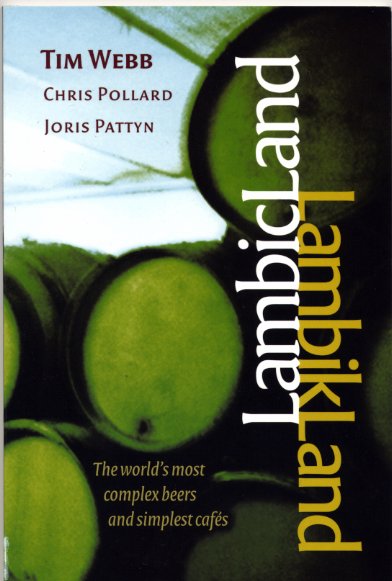Book Review:
LambicLand by Tim Webb, Chris Pollard and Joris Pattyn

Tim Webb is well known in Britain and the Low Countries as author of The Good Beer Guide to Belgium and Holland. Chris Pollard is a Camra member who is often to be seen running foreign beer bars at beer festivals in North Essex and will be known to most people in the area as Podge.
Joris Pattyn was a founder member of the
Objectieve Bierproevers (the former Belgian equivalent of Camra.)
Lambic is a unique beer style. Unlike every other type of beer where wild yeasts and other micro-organsims are rigourously excluded from the brewing process,
lambic is brewed with a deliberate innoculation of these organisms into the wort by leaving it overnight in shallow vessels open to the environment before it's put into wooden barrels where it ferments slowly for between six months and three years. When it's ready, some of it is sent to bars to be sold as draught
lambic, the rest is blended (with a mix of new and old beer) and bottled. After this has undergone a secondary fermentation in the bottle and a period of maturation the result is
Geuze; a beer that is often shockingly sour and acidic yet amazingly tasty.
Fruit is often added to the barrels and allowed to steep in the beer for several months; when done right the result is a delightful sweet/sour contrast that could never be mistaken for an alco-pop. The commonest fruits used are cherries (the resultant beer being known as
Kriek) and raspberries (
Frambozen) though other fruits are often used.
The micro-organsims necessary for the produciton of
lambic are endemic to the Zenne valley in Belgium, so it is only produced in a relatively small area in and around Brussels, mainly in the
Payottenland to the west and south of the city.
In a slim volume, the three authors present an introduction to
lambic beers, an overview of the brewers and their beers and finally a guide to the
lambic cafés of the
Payottenland, the area around the west and south of Brussels where most
lambic brewers and cafés are to be found. The introduction is necessarily brief and to the point, explaining a little of the history of the style and how it's brewed.
The brewery information covers all 11 remaining
lambic brewers, plus the recently closed Oud Beersel. Readers familiar with Tim Webb's
Good Beer Guide to Belgium and Holland will not be surprised to find that the producers of poor-quality beers are given short shrift. Although the term
Oude Geuze is legally protected in Belgium and any bottle bearing that appellation will contain either 100%
lambic or very near that amount and be re-fermented in the bottle, a Royal Proclamation of 1993 allowed the term
lambic to be used on any product which has had any of the real thing used at any time in its production, with the result that certain brewers can get away with selling lager-based beers with a dash of
lambic and calling them
geuze. Needless to say, these brewers don't get off lightly in the book. As with Tim's better known book, there is a short article about each brewer and a list of their
lambic beers with descriptions and ratings.
The biggest part of the book is the review of
Payottenland Cafés where
lambic can be enjoyed. This is undoubtedly the most useful section, since the rarity of draught
lambic means that cafés selling it are few and far between, so it can be hard to find them without help. Everything you need to know about each café is included, such as its opening hours, the beers (
lambic and other) it stocks and what sort of food is available. Where necessary, directions to the Café are also given.
The text of the book is in both Dutch and English, which will undoubtedly increase its potential market. I understand that half of the initial print-run of 2000 copies has already been sold. It's definitely a book to buy if you're interested in
lambic and would probably be of interest to beer lovers who have recently discovered the delights of Belgian beer and who want to learn more.
Price £6.95/EUR9.95, available from
www.booksaboutbeer.com or
podgehome AT blueyonder.co.uk. Also from selected bars and beer shops in Belgium, such as the Delirium Café in Brussels or
Den Dorstvlegel in Antwerpen.

 Tim Webb is well known in Britain and the Low Countries as author of The Good Beer Guide to Belgium and Holland. Chris Pollard is a Camra member who is often to be seen running foreign beer bars at beer festivals in North Essex and will be known to most people in the area as Podge. Joris Pattyn was a founder member of the Objectieve Bierproevers (the former Belgian equivalent of Camra.)
Tim Webb is well known in Britain and the Low Countries as author of The Good Beer Guide to Belgium and Holland. Chris Pollard is a Camra member who is often to be seen running foreign beer bars at beer festivals in North Essex and will be known to most people in the area as Podge. Joris Pattyn was a founder member of the Objectieve Bierproevers (the former Belgian equivalent of Camra.)